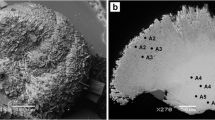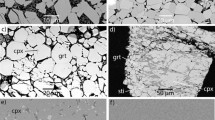Summary
C2/c pyroxene (Cpx) phenocrysts from basic rocks (basanite-trachyphonolite suite and alkali basalts) and differentiated CIPW Ne- and Q-normative trachytes and rhyolites occurring in the continental sector of the Cameroon Volcanic Line were investigated by single-crystal X-ray diffraction combined with electron probe microanalysis. This technique provides accurate data on site occupancy and geometric variations.
The investigated Cpx is the only liquidus Ca-rich crystallizing phase from both basic and differentiated volcanics.
Cpx from basic alkaline rocks are characterized by large VT owing to their low Si(T), which requires high R3+ (AlVI + Fe3+ + Cr3+ + Ti4+) in M1 site, due to Si-AlIV substitution. High Ca content allows the appropriate netcharge for the overbonded O3 oxygens.
Cpx from differentiated silicic volcanics have large VM1 related to high Fe2+ (M1), since Cpx crystallized from MgO-poor (< 0.5 wt%) melts at relatively low fO2 (QFM buffer). The high Fe2+ (M1) causes lengthening of 〈M1-O〉, which requires shortening of T-O1 and T-O2 (i.e. high Si), irrespective of the magmatic affinity of the Cpx in SiO2-undersaturated or oversaturated conditions. Therefore, Cpx from silicic rocks have similar (Ca + Na) contents to those formed from basic rocks, but their 〈M2-O3〉 is relatively longer, owing to the shortening of 〈T-O3〉. It follows that Cpx crystallizing from silicic melts show a relatively large VM2 increase, which is not related to an increase in (Ca + Na).
The β-ΔM2 (distortion parameter) relationship of Cpx indicates that the basic magmas parental to Q-normative rocks were slightly to moderately alkaline basalts and not SiO2-undersaturated or oversaturated, while those from trachyphonolite and Ne-trachyte were distinctly more SiO2-undersaturated (e.g. basanitic magmas).
Vcell–VM1 relationships confirmed that the investigated Cpx phenocrysts crystallized in the crust at relatively low pressure (ca. 1–5 kbar).
Zusammenfassung
Ca-reiche Pyroxene von basischen und sauren Gesteinen der Cameroon Volcanic Line (Westafrika): Kristallchemie und petrologische Beziehungen
C2/c Pyroxenphänokristalle aus basischen Gesteinen (Basanit–Trachyphonolith-Suite und Alkalibasalte) und differenzierte CIPW Ne- und Q-normative Trachyte und Rhyolithe, die im kontinentalen Sektor der Cameroon Volcanic Line auftreten, wurden mittels Einkristall-Röntgendiffraktion, ergänzt durch Elektronenmikrosonden-Analyse, untersucht. Diese Technik ermöglicht genaue Angaben zur Besetzung der Gitterpositionen und der geometrischen Variationen.
Der untersuchte Klinopyroxen ist die einzige kristallisierende Ca-reiche Liquidusphase, sowohl in den basischen als auch in den differenzierten Vulkaniten. Klinopyroxene aus alkalischen Gesteinen sind durch große VT, als Folge von niedrigem Si(T) und von Si-AlVI Substitution, charakterisiert, was wiederum hohe R3+(AlVI + Fe3+ + Cr3+ + Ti4+) in der M1 Position erforderlich macht. Klinopyroxene aus differenzierten sauren Vulkaniten haben ein großes VM1. Dies steht mit hohen Fe2+ (M1) Gehalten in Beziehung, da Klinopyroxen aus MgO-armen (< 0.5 Gew.%) Schmelzen bei relativ niedrigem fO2 (QFM Buffer) auskristallisierte. Die hohen Fe2+-Gehalte in M1 verursachen eine Verlängerung der 〈M1-O〉 Abstände, was wiederum eine Verkürzung der T-O1 und T-O2 Abstände (i.e. hohes Si) erforderlich macht, ungeachtet der magmatischen Affinität des Klinopyroxens in SiO2-untersättigten oder -übersättigten Bedingungen. Daher haben Klinopyroxene aus sauren Gesteinen ähnliche (Ca + Na)- Gehalte wie jene aus basischen; aber ihr 〈M2-O3〉 ist, als Folge der 〈T-O3〉 Verkürzung, relativ länger. Daraus folgt, daß Klinopyroxene, die aus silikatischen Schmelzen auskristallisieren eine relativ große Zunahme in VM2 zeigen, die aber nicht mit einer Zunahme von (Ca + Na) in Beziehung steht. Die β-ΔM2 (Verzerrungsparameter) Beziehung zeigt, daß die basischen Magmen, die Stammagmen der Q-normativen Gesteine, leicht bis mäßig alkalische Basalte waren und nicht SiO2-untersättigte oder -übersättigte. Jene der Trachyphonolithe und Ne-Trachyte waren deutlicher SiO2-untersättigt (z.B. die basanitischen Magmen). Die Beziehungen von Vcell-VM1 bestätigen, daß die Klinopyroxenphänokristalle in der Kruste bei relativ niedrigen Drucken (ca. 1–5 kbar) kristallisierten.
Similar content being viewed by others
Author information
Authors and Affiliations
Additional information
Received July 27, 1998; revised version accepted July 14, 1999
Rights and permissions
About this article
Cite this article
Salviulo, G., Secco, L., Marzoli, A. et al. Ca-rich pyroxene from basic and silicic volcanic rocks from the Cameroon Volcanic Line (West-Africa): crystal chemistry and petrological relationships. Mineralogy and Petrology 70, 73–88 (2000). https://doi.org/10.1007/s007100070014
Issue Date:
DOI: https://doi.org/10.1007/s007100070014




